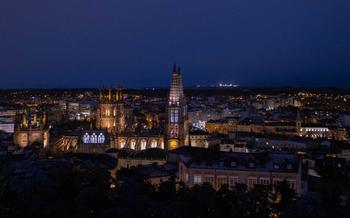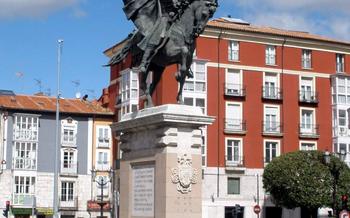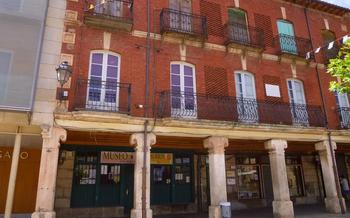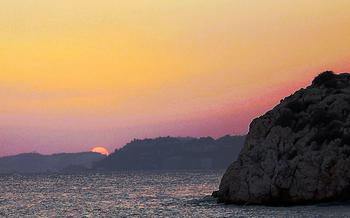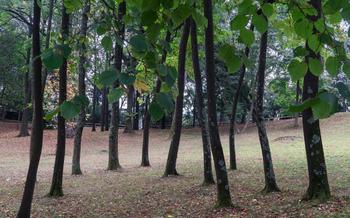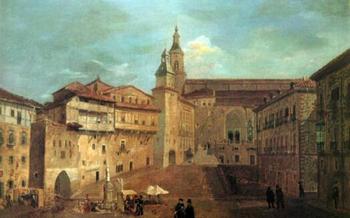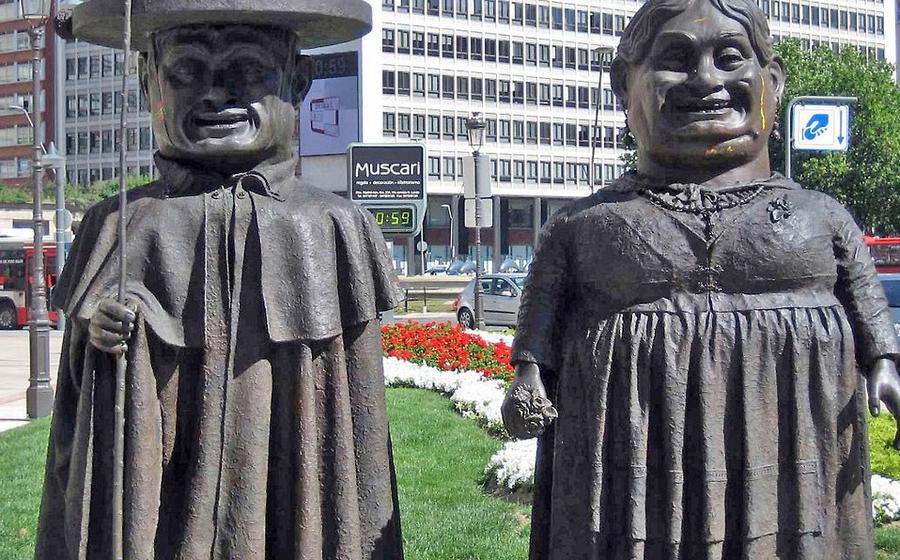
Cueva de la Peña de Candamo
- Location: A Hidden Gem in Burgos
- Guided Tours: Exploring Safely and Informatively
- Entry Fees and Opening Hours: Planning Your Visit
- The Guided Tour Experience: What to Expect
- Marvelous Stalactites and Stalagmites
- Underground Lakes and Rivers: A Watery Wonder
- Unique Fauna in the Cave: Adapting to Darkness
- The Ancient Cave Paintings: A Glimpse into History
- Unforgettable Photo Opportunities
- The Cave's Role in Local Culture and Folklore
- Nearby Attractions: Enriching Your Trip
- Insider Tip: Secret Spot for a Unique Perspective
Location: A Hidden Gem in Burgos
Nestled in the heart de Candamo is a hidden gem waiting to be discovered. Concealed within a rugged limestone massif, this subterranean wonderland lies in the province of Burgos, in the autonomous community of Castilla y León, Spain. To reach this natural wonder, visitors can embark on a scenic road trip, following the winding roads that lead to the village of Villalba de Losa**. From there, a short walk through the picturesque countryside will reveal the entrance to this subterranean masterpiece.
For those without access to a car, public transportation options are available, connecting visitors to the nearby towns and villages. From these hubs, local buses or taxis can be arranged to complete the journey to the cave. The surrounding area offers a wealth of natural beauty, inviting visitors to explore the verdant landscapes and discover the diverse flora and fauna that inhabit this region of Spain.
Guided Tours: Exploring Safely and Informatively
To fully appreciate the wonders of the Cueva de la Peña de Candamo, embarking on a guided tour is highly recommended. Not only will you be accompanied by knowledgeable experts who can unravel the cave's secrets, but you'll also ensure your safety and minimize any potential risks. Guided tours are conducted by experienced guides who possess an in-depth understanding of the cave's geology, history, and unique features. They'll lead you through the intricate network of chambers and passages, providing insightful commentary and answering any questions you may have. Tours are available in multiple languages, catering to international visitors from diverse backgrounds. Advance booking is advisable to secure your spot, especially during peak tourist seasons. Embrace the opportunity to explore this subterranean marvel with the guidance of experts and delve into the fascinating world beneath the surface.
Entry Fees and Opening Hours: Planning Your Visit
Before embarking on your subterranean adventure, it's essential to plan your visit to the Cueva de la Peña de Candamo. The cave's admission fee is typically divided into different categories to accommodate visitors of all ages and groups. Adults are usually charged a standard fee, while children may be eligible for discounted rates. Group rates are often available for larger parties, offering a cost-effective way to experience the cave's wonders.
To enhance your visit, the cave offers guided tours led by knowledgeable guides who bring the cave's history and geology to life. These tours are available in various languages, ensuring that visitors from different backgrounds can fully appreciate the cave's significance. Advance booking for guided tours is highly recommended, especially during peak tourist seasons, to avoid disappointment and secure your spot.
The Cueva de la Peña de Candamo's opening hours vary depending on the season. During the peak season, typically summer, the cave is open for longer hours to accommodate the influx of visitors. During the off-season, the hours may be reduced, so it's advisable to check the official website or contact the local tourism office for the most up-to-date information.
The cave is generally closed on certain holidays or during special events, so it's crucial to plan your visit accordingly. Public holidays and special closures are usually announced in advance, allowing you to adjust your itinerary if necessary. By carefully considering the entry fees, guided tour options, and operating hours, you can ensure a smooth and enjoyable visit to the Cueva de la Peña de Candamo.
The Guided Tour Experience: What to Expect
Guided tours of the Cueva de la Peña de Candamo offer a unique and immersive experience, allowing visitors to delve deeper into the cave's secrets and natural wonders. The tours typically last for around an hour and are led by knowledgeable and experienced guides who provide fascinating insights and explanations throughout the exploration.
Highlights of the cave covered during the tour include the impressive Hall of the Columns, with its majestic stalactite and stalagmite formations, and the underground lakes and rivers, where visitors can marvel at the crystal-clear waters and unique rock formations. Guides will also point out interesting geological features, such as stalactites and stalagmites in various stages of growth, as well as any unique or rare formations found within the cave.
The terrain inside the cave is generally easy to navigate, with well-maintained walkways and lighting. However, visitors should be prepared for some uneven surfaces and may need to stoop or crouch in certain areas due to low ceilings. Comfortable shoes and clothing are recommended, as well as a light jacket or sweater as the temperature inside the cave can be cool and humid.
Marvelous Stalactites and Stalagmites
Inside the Cueva de la Peña de Candamo, the breathtaking spectacle of stalactites and stalagmites awaits visitors. Over millions of years, water droplets seeped through the limestone ceiling, depositing minerals that gradually formed these mesmerizing formations. The stalactites, hanging like chandeliers from the ceiling, meet the stalagmites rising from the ground, creating a captivating display of natural artistry.
The colors and shapes of these cave formations are a sight to behold. The stalactites and stalagmites come in various hues, from creamy white to golden brown, and their forms range from delicate icicles to massive pillars. The interplay of light and shadow on their surfaces adds depth and dimension to the cave, creating an ethereal atmosphere.
What sets the Cueva de la Peña de Candamo apart from other caves is the sheer abundance and diversity of its stalactites and stalagmites. The cave boasts some of the most impressive and well-preserved formations in the region, making it a true geological wonder.
Legends and stories have long been associated with these cave formations. Locals believed that the stalactites and stalagmites were magical, possessing healing powers or the ability to grant wishes. These legends add an aura of mystery and enchantment to the already captivating experience of exploring the Cueva de la Peña de Candamo.
Underground Lakes and Rivers: A Watery Wonder
Beneath the grand caverns of the Cueva de la Peña de Candamo, a hidden world of water awaits. Underground lakes, with their translucent depths and crystal-clear visibility, reflect the intricate rock formations like shimmering mirrors. The water's surface is often undisturbed, allowing visitors to marvel at the perfect reflection of the cave's ceiling, creating an ethereal and awe-inspiring sight.
In addition to the still waters of the lakes, the cave also boasts a network of underground rivers. These rivers, fed by subterranean springs, flow gently through the chambers, creating a sense of tranquility and fluidity. The water's gentle lapping against the cave walls adds to the immersive experience, making visitors feel as though they have stepped into a hidden oasis.
The combination of these underground lakes and rivers creates a unique and unforgettable experience for visitors. Whether admiring the reflections on the still waters or listening to the gentle flow of the rivers, the watery wonders of the Cueva de la Peña de Candamo are sure to leave a lasting impression.
Unique Fauna in the Cave: Adapting to Darkness
The Cueva de la Peña de Candamo is home to a unique ecosystem of cave-dwelling species that have adapted to the dark and humid conditions. These creatures have evolved remarkable adaptations to survive in this challenging environment. Many species are blind or have reduced vision, relying on other senses such as hearing and touch to navigate and hunt. Some have developed pale or albino coloration, a result of the lack of sunlight.
One of the most fascinating adaptations is the ability of some cave-dwelling animals to enter a state of torpor, reducing their metabolic rate and conserving energy during periods of food scarcity. This allows them to survive for extended periods without food.
The cave ecosystem is fragile and easily disturbed, making conservation efforts crucial. Limiting human impact and maintaining a stable environment are essential for the survival of these unique and specially adapted creatures. Visitors are encouraged to follow guidelines and regulations to protect the delicate balance of the cave's ecosystem.
The Ancient Cave Paintings: A Glimpse into History
The Cueva de la Peña de Candamo holds a captivating secret within its chambers: ancient cave paintings that offer a glimpse into the lives and beliefs of our ancestors. These paintings, discovered in the early 20th century, are believed to date back to the Upper Paleolithic period, making them a treasure trove of prehistoric art.
The paintings depict a variety of subjects, including animals such as horses, bison, and deer, as well as human figures engaged in hunting and ritualistic activities. The artists used a range of techniques, including charcoal, ochre, and engravings, to create these vivid representations of their world.
The significance of these cave paintings lies not only in their artistic merit but also in the insights they provide into the cultural and spiritual beliefs of the people who created them. The images offer a glimpse into the daily lives, hunting practices, and religious rituals of these ancient inhabitants of the region.
By studying these cave paintings, archaeologists and historians have gained valuable knowledge about the development of human societies and the evolution of artistic expression in prehistoric times. The Cueva de la Peña de Candamo, with its rich collection of ancient rock art, stands as a testament to the creativity and cultural heritage of our ancestors.
Unforgettable Photo Opportunities
The Cueva de la Peña de Candamo presents an unparalleled opportunity for photographers. The unique formations, with their intricate details and diverse colors, beg to be captured. To make the most of your visit, consider the following tips:
-
Embrace the Darkness: Embrace the darkness and low-light conditions. Using a tripod and adjusting your camera settings can help you achieve crisp and clear shots even in dimly lit areas.
-
Explore Different Perspectives: Take your time and explore different angles and vantage points to find unique compositions. Experiment with close-ups of the formations or capture the grandeur of the larger chambers.
-
Utilize Natural Light: Natural light plays a crucial role in cave photography. Plan your visit during the golden hours of sunrise or sunset to take advantage of the soft, warm light that illuminates the cave's interior.
-
Consider Specialized Lighting: If possible, bring specialized lighting equipment, such as a flashlight or headlamp, to illuminate specific features or create dramatic effects.
-
Capture Reflections: The crystal-clear waters of the underground lakes offer stunning reflections of the cave formations. Use this natural mirror to your advantage for captivating shots.
-
Be Patient: Patience is key in cave photography. Take your time, observe the cave's intricate details, and wait for the perfect moment to capture the essence of this subterranean wonder.
The Cave's Role in Local Culture and Folklore
The Cueva de la Peña de Candamo holds a special place in the hearts and minds of the local community. Over centuries, it has been a source of inspiration, wonder, and mystery, weaving its way into the fabric of local culture and folklore. Ancient legends speak of hidden treasures guarded by mythical creatures within the cave's depths, while tales of brave explorers venturing into its unknown realms captivate the imagination. The cave has become an integral part of local traditions and festivities, with special events and ceremonies held in its honor. These events celebrate the cave's unique heritage and pay homage to its enduring significance in shaping the local identity and cultural landscape.
Nearby Attractions: Enriching Your Trip
Beyond the Cueva de la Peña de Candamo, the region offers a wealth of other attractions that will enhance your trip. For more cave exploration, consider visiting the nearby Ojo Guareña Natural Park, home to a network of caves with impressive stalactites and stalagmites. History buffs can explore the medieval town of Frías, with its well-preserved castle and cobblestone streets. Nature enthusiasts will delight in the stunning scenery of the Ebro Canyon, offering hiking trails and breathtaking views.
To immerse yourself in local culture, visit the charming villages of Oña and Poza de la Sal, known for their historic monasteries and traditional festivals. Indulge in the regional cuisine, savoring dishes like Burgos suckling pig and morcilla sausages, paired with local wines from the Ribera del Duero region. Don't miss the chance to visit the La Yecla Archaeological Site, where you can marvel at ancient rock art and gain insights into the region's prehistoric past.
Insider Tip: Secret Spot for a Unique Perspective
For a truly breathtaking experience, venture beyond the main tourist routes and discover a hidden gem within the Cueva de la Peña de Candamo. Tucked away in a secluded corner of the cave, a secret viewpoint awaits those willing to explore.
To find this hidden spot, follow the path until you reach a narrow passage. Squeeze through the opening and continue until you find yourself in a small chamber. Here, you'll be rewarded with a unique perspective of the cave's majestic formations.
The best time to visit this secret spot is early in the morning or late in the afternoon, when the light filters through the cave's openings, creating a magical ambiance. Capture the ethereal beauty of the stalactites and stalagmites as they shimmer in the soft light.
Remember to respect the cave's delicate ecosystem and avoid touching or damaging the formations. Take your time to soak in the tranquility of this hidden gem, and create lasting memories of your visit to the Cueva de la Peña de Candamo.
